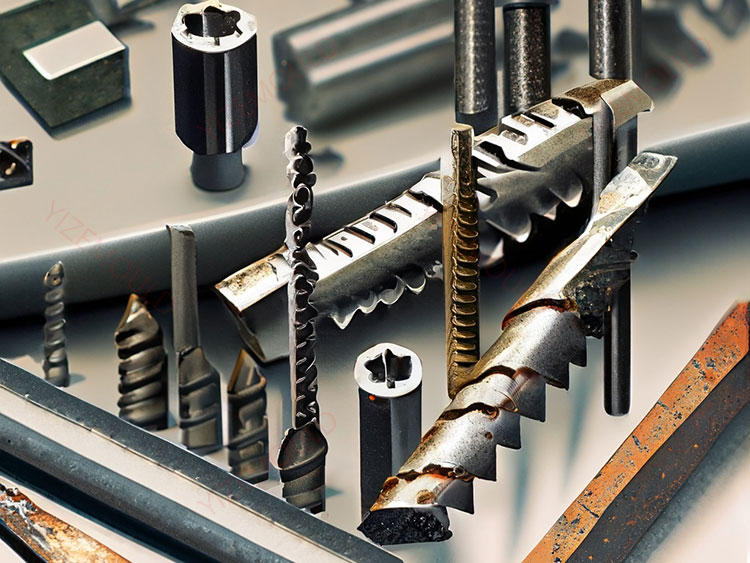Oxidation method for recycling tungsten carbide
Approximately one-third of tungsten demand comes from tungsten-containing waste. Due to the diverse types of tungsten-containing waste materials, there are various methods for recycling. The commonly used methods include oxidation, […]
Approximately one-third of tungsten demand comes from tungsten-containing waste. Due to the diverse types of tungsten-containing waste materials, there are various methods for recycling. The commonly used methods include oxidation, electrolysis, and zinc melting.
Oxidation Method.
The oxidation method refers to the regeneration process of tungsten by first reacting the waste tungsten carbide-cobalt metal (hard alloy) or residual tungsten metal with oxygen to form tungsten and cobalt oxides, and then reacting with alkali to generate water-soluble sodium tungstate, which separates from solid cobalt oxide. In production, potassium nitrate or oxygen-enriched air is commonly used as the oxidant, leading to two variations: the potassium nitrate smelting method and the oxygen-enriched air oxidation method.
Our factory business: carbide parts, mold parts, medical injection molds, precision injection molds, teflon PFA injection molding, PFA tube fittings. email: [email protected],whatsapp:+8613302615729.

Scrap tungsten carbide
1. Potassium Nitrate Smelting Method.
The potassium nitrate smelting method is the earliest industrial application for recycling waste carbide. It utilizes potassium nitrate (sodium nitrate) and oxygen from air as oxidants to convert tungsten in the hard alloy waste into tungsten trioxide, which then reacts with sodium oxide, a decomposition product of sodium nitrate, to form soluble sodium tungstate. The main reactions involved are as follows:
- 2NaNO3 = 2NaO + 2O2 + N₂
2WC + 5O2 – 2W + 2CO2(g)
WC + CO2 – W + 2CO(g)
WO3 + Na2O – Na2WO4
The smelting process takes place in a reverberatory furnace using heavy oil or gas as fuel. When the temperature reaches the melting point of potassium nitrate, the molten potassium nitrate reacts vigorously with the waste tungsten raw materials, rapidly raising the temperature to 1073-1173 K. After stirring and fusion for 1 hour, the molten product is discharged. After cooling, crushing, leaching, and filtration, Na2WO4 solution and Co2O3 slag are obtained.
The obtained Na2WO4 solution can be used to produce tungsten trioxide through the following process: sodium tungstate solution → hydrochloric acid precipitation → tungstic acid precipitation → ammonia solution filtration → evaporation and crystallization → filtration and washing → ammonium metatungstate → calcination → tungsten trioxide. The cobalt slag is leached with hydrochloric acid to obtain cobalt chloride solution, which is then purified using conventional methods. Alternatively, cobalt slag can be dissolved with nitric acid to generate nitric acid cobalt solution, which, after purification, can be mixed with Na2WO4 solution to produce tungsten-cobalt co-precipitate. The tungsten-cobalt co-precipitate can be further processed through calcination and hydrogen reduction to obtain fine-grade tungsten-cobalt composite powder for the production of carbide.
The potassium nitrate smelting method is suitable for processing various tungsten-containing waste materials and has the advantages of fast reaction, high production capacity, and high tungsten recovery rate. The tungsten recovery rate can reach 98%-99% from the alkaline decomposition slag of black tungsten ore. However, this method also generates a large amount of NO2 gas, which pollutes the environment during the smelting process. When using relatively inexpensive sodium sulfate as a substitute for potassium nitrate, although the environmental pollution is reduced, the emitted SO2-containing gas must also be treated. The equipment used when using sodium sulfate as the oxidant is the same as that used when using potassium nitrate, but the melting temperature is as high as 1373 K, and the fusion time requires 2-3 hours to achieve the same effect as the potassium nitrate method.
2. Oxygen-Enriched Air Oxidation Method.
The oxygen-enriched air oxidation method involves introducing oxygen-enriched air into a preheated oxidizing furnace at temperatures ranging from 1073 to 1173 K. In this process, tungsten in the waste materials is first oxidized to WO3, and then WO3 is dissolved in alkali to obtain a Na2WO4 solution. Once the oxidation reaction begins, the reaction heat and oxygen supply are used to control the reaction temperature, eliminating the need for an external heat source. The oxidation time typically ranges from 2 to 7 hours, depending on the nature and shape of the tungsten-containing waste materials. The oxidation products are usually subjected to ball milling and sieving, with the oversize material being returned for further oxidation and the undersize material dissolved in alkali to obtain a Na2WO4 solution. The Na2WO4 solution can be used to produce ammonium paratungstate or other tungsten products using conventional methods. If the tungsten-containing waste materials also contain cobalt, cobalt can be recovered from the insoluble residue after alkali dissolution. Since WO3 sublimes at the oxidation temperature, some loss of WO3 due to sublimation is inevitable, resulting in tungsten recovery rates typically ranging from 94% to 97% for the production of Na2WO4. This method is suitable for processing various tungsten-containing waste materials, such as rods, bars, wires, plates, metal tungsten, and tungsten carbide. It can also be used to process tungsten powder, WC powder, and other tungsten-containing waste materials using the method of self-igniting oxygen after ignition to reduce the loss of WO3 due to sublimation.






